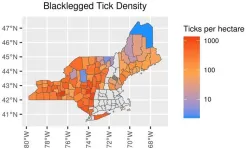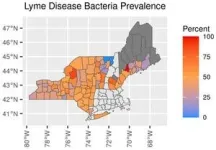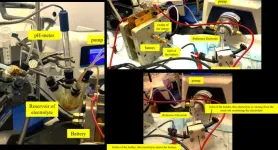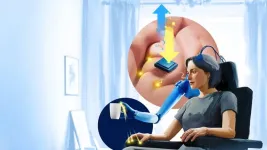(Press-News.org) Across most of the Northeast, getting bitten by a blacklegged tick— also called a deer tick — is a risk during spring, summer, and fall. A new Dartmouth study, published in Parasites and Vectors, finds that 50% of adult blacklegged ticks carry the bacteria that causes Lyme disease while 20% to 25% of the younger (nymph) blacklegged ticks carry the bacteria.
A team of researchers from universities, health departments, and agricultural agencies from across the Northeast conducted a meta-analysis of data on how many blacklegged ticks there are and how many of them have the potential to pass pathogens responsible for Lyme disease and three other tick-borne diseases in the Northeast from 1989 to 2021, including in Connecticut, New York, New Hampshire, Vermont, and Maine.
Data was collected in Maine starting in 1989, while most of the other states began data collection in the mid- 2000s. Massachusetts and Rhode Island were not represented in the study due to either unavailable or insufficient data.
Lyme disease was first discovered in Lyme, Conn, in 1975. Its symptoms can vary depending on the stage and severity of the disease but can include a rash, fever, chills, fatigue, muscle or joint aches, and swollen lymph nodes. If left untreated, prolonged and more severe symptoms may develop.
Lyme disease is caused by a bacteria called Borrelia burgdorferi. Some but not all, white-footed mice, chipmunks, birds, squirrels, and other small animals carry the bacteria in their blood, making them "competent" hosts. Blacklegged ticks are not born infected with the Lyme disease bacteria. But when a blacklegged tick feeds on an infected host, the tick can get the bacteria that causes Lyme disease and then potentially spread it to humans through its bite. Other animals, like white-tailed deer, are “incompetent hosts”, so while they are a food source for blacklegged ticks, they do not transmit the Lyme disease bacteria.
Blacklegged ticks typically consume three blood meals over the course of a two-year life cycle: after they hatch into larvae in the midsummer of their first year; as nymphs during the following late spring, often in May or June; and as adults that fall, most likely between September and November.
In general, ticks must be attached to a person for at least 24 hours to transmit the Lyme disease bacteria. So even though adult blacklegged ticks are more likely to carry the bacteria than younger ticks, because they are bigger, about the size of a sesame seed, there is particular concern about the younger ticks or nymphs, which are only about the size of a poppy seed, making them difficult to spot.
"While the bacteria responsible for Lyme disease has a complicated chain of transmission, our results show the relative abundance of blacklegged ticks, and just how many of them are carrying disease-causing pathogens throughout the Northeast," says lead author Lucas Price, who was a postdoctoral fellow in geography at Dartmouth at the time of the study and is now a wildlife biologist at the Interior Department’s Bureau of Land Management.
The researchers analyzed the abundance of blacklegged ticks and the presence of Lyme disease bacteria and other pathogens so that they could determine how blacklegged ticks and the pathogens they carry are changing in time and space.
“Contrary to the well-documented spread of blacklegged ticks and Lyme disease over the past 30 years, we found very small changes in the abundance of blacklegged ticks, but think this is likely because we usually don’t start sampling a location for blacklegged ticks until they’re already established,” says senior author Jonathan Winter, an associate professor of geography and director of the Applied Hydroclimatology Group at Dartmouth. However, we did find an increase in the percentage of blacklegged ticks that carry the Lyme disease bacteria.”
These findings underscore advice from the Centers for Disease Control and Prevention and health professionals, who recommend a range of tick bite prevention measures, including conducting full-body tick checks after spending time outdoors in regions where pathogen-carrying ticks are present. While much of the data were already available publicly prior to the study, the team made the surveys consistent across states, creating one of the most comprehensive tick abundance and pathogen prevalence datasets in the United States, and establishing a baseline that can be used in the future.
The researchers have another study underway examining the relationship between climate change and the prevalence of blacklegged ticks and Lyme disease in the Northeast.
Joseph Savage, a graduate student in the Ecology, Evolution, Environment & Society program at Dartmouth, also contributed to the study.
Study co-authors Price (lucas.e.price@dartmouth.edu) and Winter (jonathan.m.winter@dartmouth.edu) are available for comment.
###
END
In the Northeast, 50% of adult ticks carry Lyme disease carrying bacteria
Study maps tick abundance and Lyme disease bacteria prevalence over 30 years.
2025-01-16
ELSE PRESS RELEASES FROM THIS DATE:
U of A Cancer Center clinical trial advances research in treatment of biliary tract cancers
2025-01-16
TUCSON, Arizona — The results of a clinical trial led by researchers at the University of Arizona Health Sciences and published in the Journal of Clinical Oncology showed that chemotherapy combining three different types of drugs did not improve overall survival for patients with advanced stage, inoperable biliary tract cancers.
“Biliary tract cancer is comparatively rare, but it’s aggressive and spreads fast. Our accrual of more than 450 patients in a little more than two years really shows there is a need for new ways to help people with biliary tract cancer,” ...
Highlighting the dangers of restricting discussions of structural racism
2025-01-16
PHILADELPHIA (January 16, 2025) – A new Health Affairs Health Policy Brief highlights the detrimental impact of recent state and federal policies that restrict discussions of “divisive concepts,” including structural racism. It warns that these policies undermine efforts to address health inequities and improve population health.
“By limiting discussions of structural racism, these policies ignore the historical and environmental factors that shape health outcomes,” said co-author Derek Griffith, PhD, the Risa Lavizzo-Mourey ...
NYU Tandon School of Engineering receives nearly $10 million from National Telecommunications and Information Administration
2025-01-16
NYU Tandon, collaborating institutions and industry partners have been awarded nearly $10 million to develop next generation communications technology.
The project, dubbed SALSA (Spectrally Agile Large-Scale Arrays), is funded by the U.S. Department of Commerce's National Telecommunications and Information Administration (NTIA) to advance U.S. leadership in open, secure communications infrastructure.
SALSA aims to create advanced wireless systems that operate in the "upper mid-band" spectrum — a region of frequencies relatively ...
NASA scientists find new human-caused shifts in global water cycle
2025-01-16
In a recently published paper, NASA scientists use nearly 20 years of observations to show that the global water cycle is shifting in unprecedented ways. The majority of those shifts are driven by activities such as agriculture and could have impacts on ecosystems and water management, especially in certain regions.
“We established with data assimilation that human intervention in the global water cycle is more significant than we thought,” said Sujay Kumar, a research scientist at NASA’s Goddard Space Flight Center in Greenbelt, Maryland, and a co-author ...
This tiny galaxy is answering some big questions
2025-01-16
Leo P, a small galaxy and a distant neighbor of the Milky Way, is lighting the way for astronomers to better understand star formation and how a galaxy grows.
In a study published in the Astrophysical Journal, a team of researchers led by Kristen McQuinn, a scientist at the Space Telescope Science Institute and an associate professor in the Department of Physics and Astronomy at the Rutgers University-New Brunswick School of Arts and Sciences, has reported finding that Leo P “reignited,” reactivating during a significant period on the timeline of the universe, producing stars when many other small galaxies didn’t.
By ...
Large and small galaxies may grow in ways more similar than expected
2025-01-16
A team of astronomers led by University of Arizona researcher Catherine Fielder has obtained the most detailed images of a small galaxy and its surroundings, revealing features typically associated with much larger galaxies. The observations provide a rare, elusive glimpse into how small galaxies form and evolve, suggesting that the mechanisms fueling galaxy growth may be more universal than previously thought.
Fielder presented the findings at the 245th meeting of the American Astronomical Society in National Harbor, Maryland, during a press briefing ...
The ins and outs of quinone carbon capture
2025-01-16
Carbon capture, or the isolation and removal of carbon dioxide from the atmosphere during industrial processes like cement mixing or steel production, is widely regarded as a key component of fighting climate change. Existing carbon capture technologies, such as amine scrubbing, are hard to deploy because they require significant energy to operate and involve corrosive compounds.
As a promising alternative, researchers from the Harvard John A. Paulson School of Engineering and Applied Sciences (SEAS) have developed carbon capture systems that use molecules called ...
Laboratory for Laser Energetics at the University of Rochester launches IFE-STAR ecosystem and workforce development initiatives
2025-01-16
The University of Rochester’s Laboratory for Laser Energetics (LLE) has been awarded a $2.25 million grant over three years from the US Department of Energy’s Office of Fusion Energy Sciences. This funding establishes the Inertial Fusion Energy Science and Technology Accelerated Research (IFE-STAR) ecosystem that brings together academia, national laboratories, and the private sector to develop a clean, safe, and virtually limitless energy source, built on US leadership in inertial fusion.
Inertial ...
Most advanced artificial touch for brain-controlled bionic hand
2025-01-16
For the first time ever, a complex sense of touch for individuals living with spinal cord injuries is a step closer to reality. A new study published in Science, paves the way for complex touch sensation through brain stimulation, whilst using an extracorporeal bionic limb, that is attached to a chair or wheelchair.
The researchers, who are all part of the US-based Cortical Bionics Research Group, have discovered a unique method for encoding natural touch sensations of the hand via specific microstimulation patterns in implantable electrodes in the brain. This allows individuals with spinal cord injuries ...
Compounding drought and climate effects disrupt soil water dynamics in grasslands
2025-01-16
A novel field experiment in Austria reveals that compounding climate conditions – namely drought, warming, and elevated atmospheric carbon dioxide (CO2 ) – could fundamentally reshape how water moves through soils in temperate grasslands. The findings provide new insights into post-drought soil water flow, in particular. Soil water, though a minuscule fraction of Earth's total water resources, plays a critical role in sustaining terrestrial life on Earth by regulating biogeochemical cycles, surface energy balance, and plant productivity. Soils also govern ...
LAST 30 PRESS RELEASES:
Pew funds 7 new biomedical research collaborations
The ERC selects 349 mid-career researchers for €728 million in Consolidator Grants
ERC Consolidator Grant awarded to CISPA researcher Rayna Dimitrova
Antimicrobial effects of Syzygium aromaticum and Salvadora persica against common peri-implantitis pathogens in vitro
EVs pose no greater risk to pedestrians than conventional vehicles
Modeling microplastic accumulation under the ocean surface
Pompeii offers insights into ancient Roman building technology
University of Utah engineers give a bionic hand a mind of its own
Transient and long-term risks of common physical activities in people with low back pain
Health care contact days in older adults with metastatic cancer
Brain resilience science reshapes psychiatry from treating illness to building strength
An assessment of the antidepressant potential of deramciclane in two animal tests
Pitt and UPMC study finds epigenetic signature of pediatric traumatic brain injury, paves way for precision recovery tools
Brain discovery opens door to earlier detection of metabolic syndrome in women
SwRI-led study provides insight into oscillations in solar flares
Announcing the third cohort of the Hevolution/AFAR new investigator awards in aging biology and geroscience research
GeoFlame VISION: Using AI and satellite imagery to predict future wildfire risk
Nationwide study suggests that water treatment methods may impact the risk of legionnaires’ disease
Oyster larvae on drugs move slowly and are stressed
Targeting a specific brain circuit may help prevent opioid relapse, WSU study finds
Tec-Dara combination offers substantial improvement over standard second-line therapies for relapsed or refractory multiple myeloma
Improving treatment for an autoimmune bleeding condition
Drug reduced need for blood transfusions during hospitalization for non-cardiac surgery
Novel agent ianalumab added to standard therapy extends time to treatment failure in patients with previously treated immune thrombocytopenia
Pirtobrutinib outperforms bendamustine plus rituximab for previously untreated CLL/SLL
Online tracking and privacy on hospital websites
A freely available tool to document wartime destruction
Residential solar panels can raise electricity rates
Scientists use synthetic platelets as ‘Trojan horse’ drug-delivery system
Cooperative Intermolecular Interactions Regulate Supramolecular Polymer Assembly
[Press-News.org] In the Northeast, 50% of adult ticks carry Lyme disease carrying bacteriaStudy maps tick abundance and Lyme disease bacteria prevalence over 30 years.









